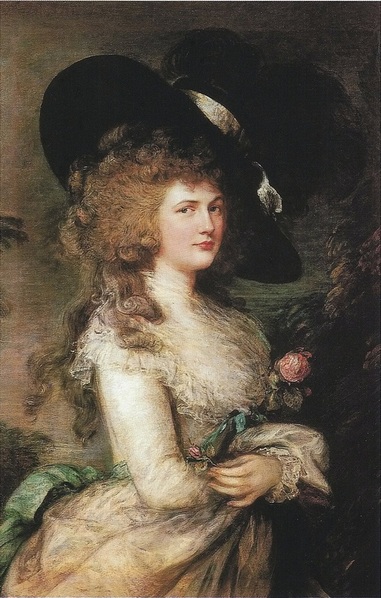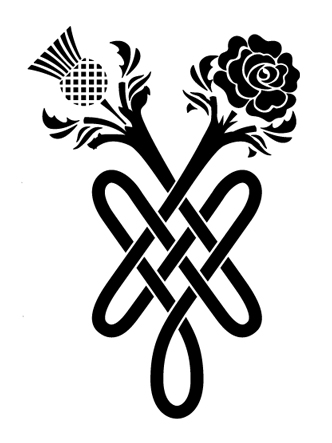
William Cavendish (1746-1811) was the 5th Duke of Devonshire. He was Lord High Treasurer of Ireland, Governor of Cork and Lord Lieutenant of Derbyshire. He best known for his the scandals which surrounded his marriage to, Lady Georgiana Spencer.
Georgiana Spencer was born in Althorp, Northamptonshire, on 7 June 1757. She was the eldest daughter of John Spencer, 1st Earl Spencer, one of the richest men in England, and Margaret Georgiana Poyntz. She had two siblings, George and Henrietta, known as Harriet, later Lady Bessborough.
By the time Georgiana, Duchess of Devonshire, was twenty-two, she was the most talked about woman in England. Her novel 'The Sylph' had gone through four printings, and she had served as the model for Lady Teazle in Richard Sheridan's 'The School for Scandal'. Wax casts of her were on sale alongside likenesses of the Prince of Wales, milliners made fans decorated with her portrait and she was nearly crushed by crowds when she appeared in public places such as the pleasure gardens at Ranelagh. Her extravagant costumes, outlandish hats and hairstyles - which rose as much as three feet above her head (and might feature a ship in full sail or a pastoral scene with sheep and trees) - were more assiduously chronicled than those of any other aristocrat in England. She was the confidante, and, it was rumoured, the lover, of the country's most charismatic politician, Charles James Fox. She was also the closest friend of the debauched, attention-seeking Prince of Wales ('Prinny' to his friends).
The vivacious Duchess of Devonshire, was 'the glass and model of fashion' and the uncontested leader of the 'ton' an amalgam of writers, actors, politicians, racy aristocrats, and libertines which, although it included less than a thousand people, set standards of taste in England during the last decades of the eighteenth century.
This willowy, russet haired beauty was, in every sense superb, except for her somewhat bulging eyes. She was also considered the most warmhearted woman in the realm. She was noted for her generosity to charities and friends alike, and famous for her capacity to make those she addressed feel as if they were the centre of the world. So it seems all the more odd that the only man who was not smitten by the Duchess was her husband, William Cavendish, fifth Duke of Devonshire. He was one of the wealthiest nobles in the nation and the owner of a magnificent art collection and many mansions (including Devonshire House and Chatsworth). His idea of a good time was to drink and play cards with his cronies at Brooks', the exclusive club where he dined nightly, year in, year out, on broiled mutton. At the same time he was betrothed to Georgiana, the duke was conducting an affair with a former milliner, Charlotte Spencer, who bore him a daughter.
In 1782, the Duke and Duchess journeyed to Bath, where they met the fascinating Lady Elizabeth Foster. She was separated from her husband and living in straightened circumstances. She eagerly seized the opportunity to improve her situation. Lady Elizabeth, known as Bess, attached herself to Georgiana and was invited to return home with the Devonshires. Bess succeeded in making herself indispensable to both Duchess and Duke, as friend to one and mistress to the other and a strange “ménage à trois” resulted. Bess bore the Duke two illegitimate children, Caroline St Jules and Augustus Clifford, and married the Duke after Georgiana’s death.
In 1783, Georgiana, known as Little G, was born. Her sister, Harriet, known as Harryo, followed two years later, but it was not until 1790, when the hope of her ever producing an heir had almost disappeared, that William, Marquess of Hartington, known as Hart, was born.
The love of Georgiana’s life was the handsome young Whig politician, Charles Grey. She embarked upon an affair with him, but in 1791 she discovered that she was carrying his child. The Duke gave her an ultimatum - give up Grey and the child or she would never see her three children again. Grey was heartbroken when she chose her children over him.
Georgiana fled abroad giving birth to Eliza Courtney in January 1792 and then handing her over to Grey’s parents to be brought up. She was never able to openly acknowledge her, although she did visit her daughter.
Eventually, the Duke sent word that she could return and in the autumn of 1793, she arrived in England after a two year absence. For several years following her exile, Georgiana lived a quiet life. She suffered a severe eye complaint, which left her blind in one eye and her face was scarred as a result of the treatment she received.
It was not until Little G was to be launched into society that Georgiana overcame her disability and once more entertained at Devonshire House. She rekindled her friendship with the Prince of Wales and became one of his main advisors.
Georgiana died on 30 March 1806 from a liver complaint. She was buried in the family vault at St Stephen’s Church, Derby, on 8 April, and society deeply mourned her passing.











 RSS Feed
RSS Feed